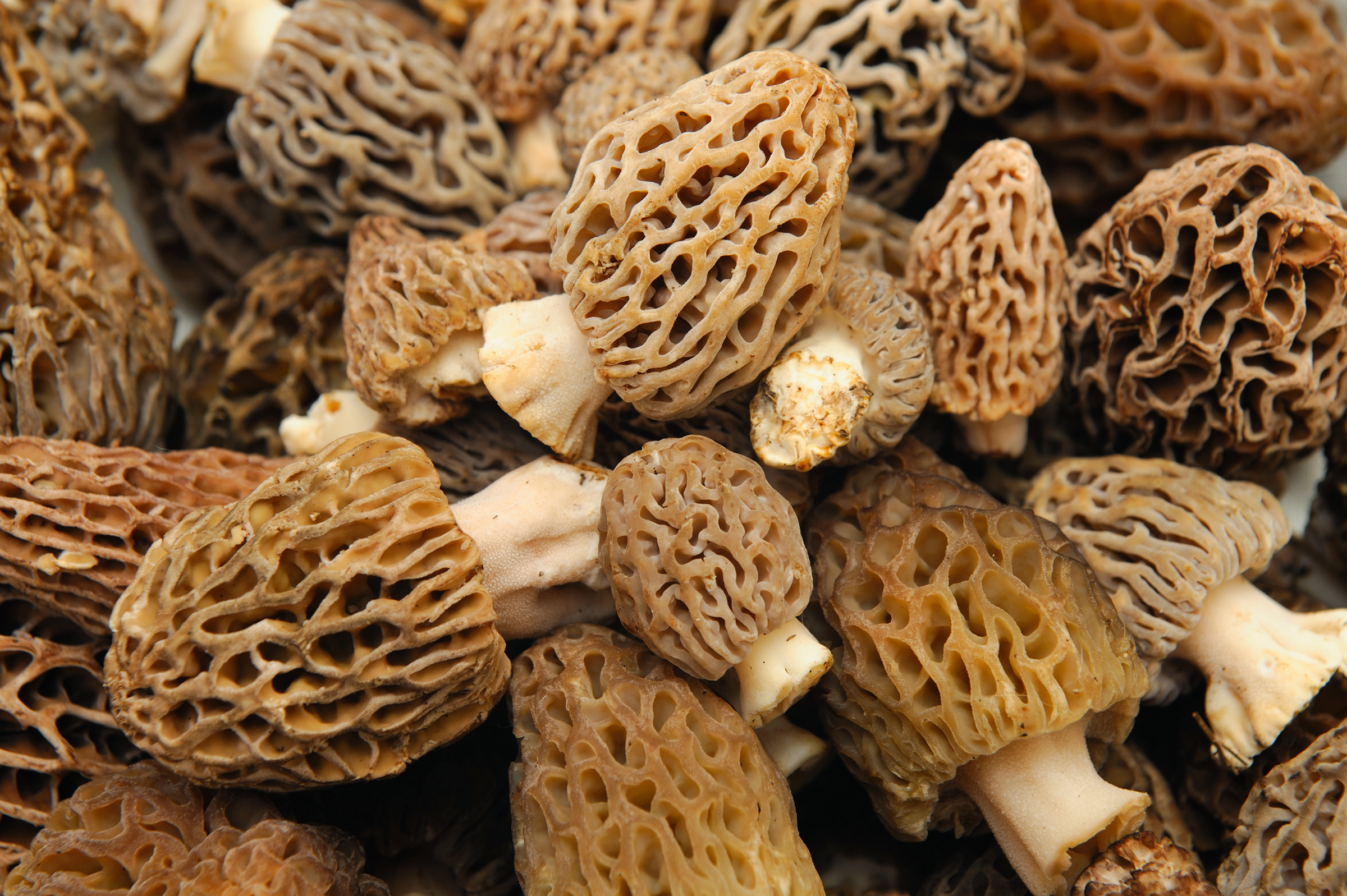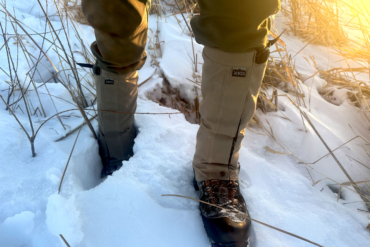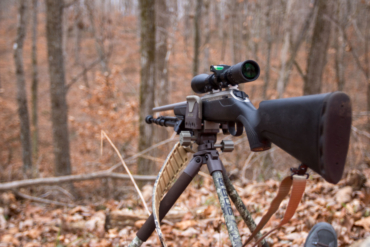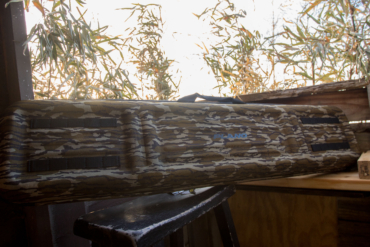Few things get foragers worked up like morel season. It’s like Christmas for mushroom nerds. And yeah, I’m one of them. These little wrinkly shrooms are straight-up gold to mycophiles. They’re flavor-packed, damn near impossible to farm, and nowhere to be found in your average grocery store. That kind of scarcity? It only makes the hunt sweeter.
As a lay mycologist myself, I get absolutely elated when the leaves start to bud on the cottonwood trees. It’s the sign that spring is here. For me, it’s the sign to head for the hills and start giving in to my fungi-gathering habit.
If you’re itching to get out there and fill your skillet with something wild, I’ve pulled together the basic tips, tricks, and enough know-how to get you into the dirt and on the trail of these elusive, edible little suckers.
DISCLAIMER: Foraging edible plants and fungi can be a dangerous endeavor. Before you consume any foraged food, be sure you have correctly identified it. If you aren’t sure, don’t eat it. You can likely find experts in your area to help you correctly identify your find. Mistakes can cost you your life.
What’s the Hype With Morel Mushrooms?
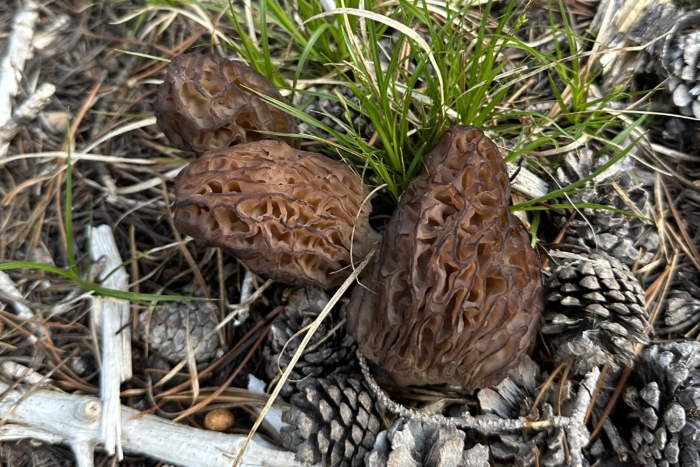
Morel mushrooms are one of the most sought-after varieties in the world.
Depending on your location and the time of year, they can demand up to $50 per pound. The reason? They are absolutely delicious and incredibly difficult to cultivate. This means if you want to get your hands on the culinary delight of morels, you’re either going to have to fork over some serious cash or lace up your hiking boots.
A Culinary Marvel
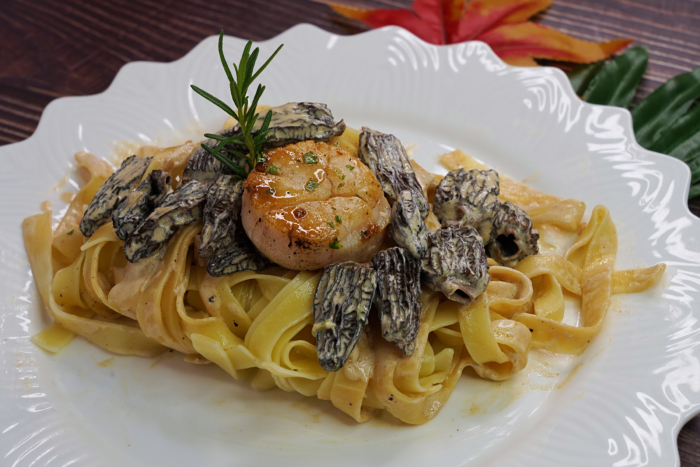
Morel mushrooms have an almost meaty texture, making them a wonderful meat substitute in cooking. Unlike other mushrooms, morels do not have the slimy texture often associated with edible fungi. The flavor of the morel itself is almost nutty but light and not overpowering.
Morels are what I like to refer to as a gateway mushroom for people not partial to the flavor or texture of mushrooms. They can turn anti-mushroom folks into mycophiles in short order.
During morel season, I utilize morels for almost every meal. It’s hard to find a meal that isn’t made exponentially better with the addition of morels. From breakfast omelets to an evening of fine dining, the morel mushroom really is the jack of all trades and … well … the master of them, too.
Types of Morel Mushrooms

There are currently 18 known different species of morel in North America, though most people identify them by color. Black, white, and yellow are the most common, but green and gray are also identifiers some foragers use. Fortunately, all morels are edible (if cooked thoroughly).
Identifying Morel Mushrooms
Mushrooms might be delicious, but they have a dangerous side. If you are thinking about foraging, you need to take the time to learn what you are doing. One wrong pick can lead to serious consequences.
The woods are full of toxic lookalikes that can cause real harm. Depending on what you eat, you might end up with an upset stomach, severe diarrhea, vivid hallucinations, or even death. This is not something to take lightly. Make sure you know exactly what you are picking before it ever hits your basket. Your health and your life depend on it.
NOT Morels
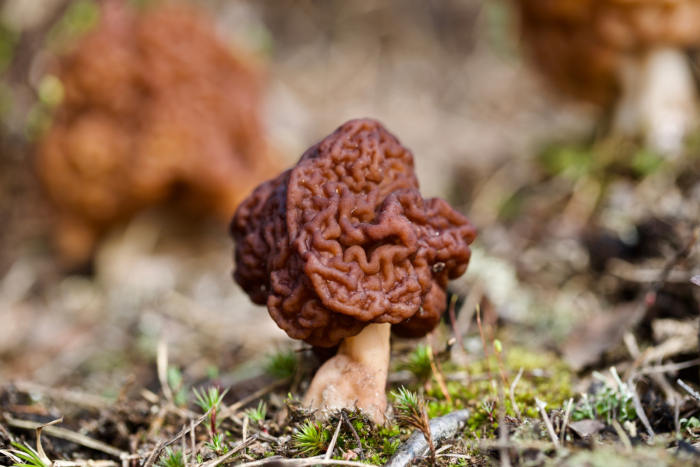
Morels do have a few lookalikes, but once you know what to look for, telling them apart is fairly straightforward. False morels usually have a wrinkled, irregular cap and a stem that is solid or only partially hollow. True morels, on the other hand, have a deeply pitted cap and are completely hollow from top to bottom.
Some sources claim that certain false morels can be eaten if prepared in a specific way. Personally, I don’t think the risk is worth it, and from what I’ve heard, they really aren’t all that good to eat, anyway.
False Morel Red Flags
- Not completely hollow, fleshy interior
- Wrinkled, brain-like cap, not pitted
- Cap disconnected from stem or only connected at the top of the stem
- More red, purple, brown colored
- Irregular, “smooshed” shape
Morel Mushrooms Identification
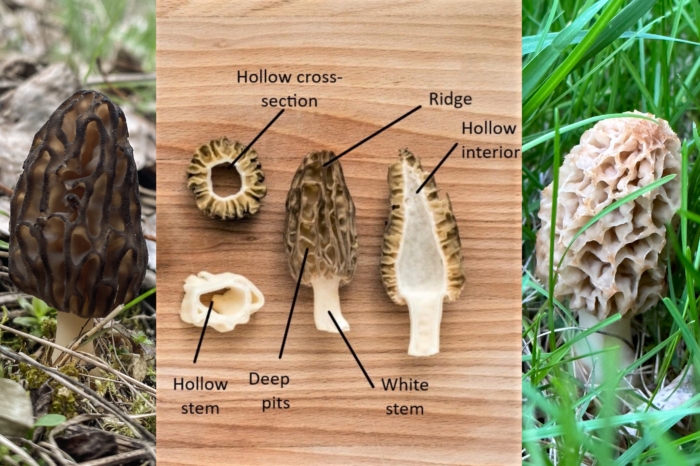
Aside from appearances, true morels have a telltale hollowness, typically lacking in their impostors. If you slice a morel from top to bottom, or if you take a cross-section, you’ll find that morels have a hollow interior from the top of their cap all the way down to their stem.
Instead of the brain-like wrinkled texture of most false morels, true morels have deep, defined pits (which are amazing for soaking up butter). Morels also tend to have a peak, growing toward a relative point. False morels often have a more squished, irregular growth.
Morel Mushroom Green Flags
- Hollow-bodied from stem to cap
- Deeply pitted cap, not wrinkled
- Fully connected stem and cap (in most cases)
- Colors ranging from black, gray, tan, yellow, and whitish
- Pointed, peaked growth
How to Find Morel Mushrooms
Let’s look at the groundwork needed to find the morels you crave. From tools needed to locations, time of year, tips, and tricks, we can help you embark on your mushroom foraging journey.
Tools Needed
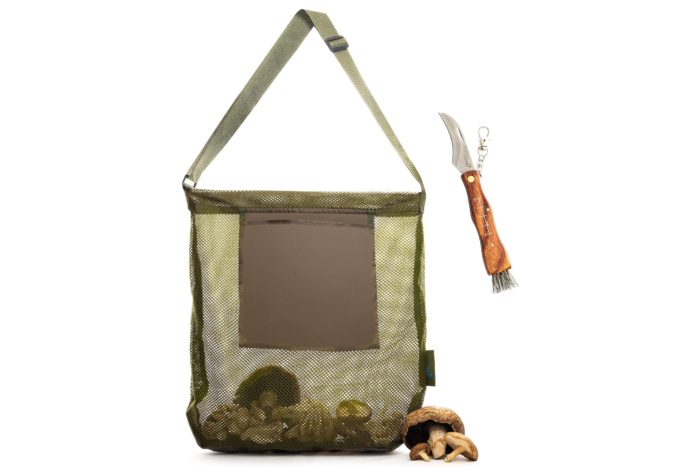
In reality, you don’t need any tools to forage for mushrooms. You can easily pop them out of the ground and toss them in a sack. However, morels are fragile, and harvesting them properly may lead to a bulkier harvest in the future (or so they say). If you get serious about foraging for mushrooms, two simple tools will be an asset.
Mushroom knife: There are specialty knives made specifically for harvesting mushrooms. They tend to have a curved blade that allows you to hook the stem just above the soil. This leaves a bit of “stem stubble” and doesn’t disrupt the mycelium below. Some, like the Opinel No. 08 Mushroom Knife, have a brush on the handle end for removing bits of debris.
Mushroom bag: A vented/mesh mushroom bag can help keep your mushrooms fresh and protected. Morels are delicate. Because of their hollow body, they are very easy to crush and break. The stems are particularly crumbly and prone to breaking.
Reusable produce bags also make great mushroom-collecting vessels. One great benefit to using a net-like bag is the idea that as you walk along, those spores are being spread, helping to propagate more mushrooms.
In reality, though, a plastic grocery bag will absolutely do the trick.
You can also save time and money by picking up this All-in-One Mushroom Foraging Kit, pictured above.
When to Look
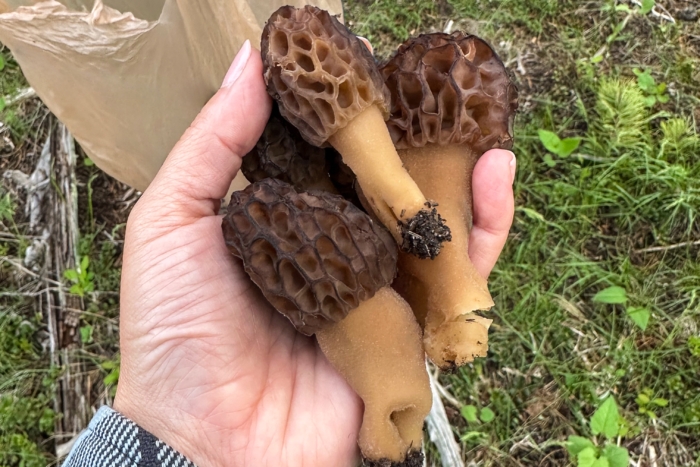
Morels have a very distinct and very short season. Spring is your time. The old rule of thumb is to start poking about as soon as the deciduous trees in your area have leaves that are just popping.
The months where morels will be most prevalent in the U.S. are March, April, May, and June. Elevation also plays a huge part in when those mushrooms will pop.
Fortunately, you can find all sorts of resources online for your specific area, including the Morel Mushroom Sightings Map, which lays out where and when people spot the first morels of the season. You’ll find the first sightings tend to be the coasts, then the low elevation central parts of the US, and finally up through the mountain ranges.
Where to Find Morel Mushrooms
If you’ve reached the time frame when morels should be popping up in your area, there are some distinct locations and signs that morels might be hiding in your vicinity. This should all be taken with a grain of salt, though.
I’ve found morels next to the parking lot of rest stops and just shooting my bow in my own yard. They are mysterious and finicky and, really, can pop up where you least expect it and not where you’d most.
Moisture
Like most fungi, morels prefer some moisture. However, they tend to prefer it drier than most. Think of the shady areas under trees that aren’t wet but have a bit of residual moisture from being shaded all day. You’ll find more morels there than you will on the riverbank or near standing water.
Trees
Trees really are your mark. Oak, elm, ash, and aspen trees are the big targets for morel foragers, though they can coexist at the base of several other species.
Because morels and trees share a mycorrhizal relationship, the mushrooms are almost always found in wooded areas. Mushrooms increase the moisture provided to the roots of the trees, while the trees provide nutrients like sugars for the morels.
Fire
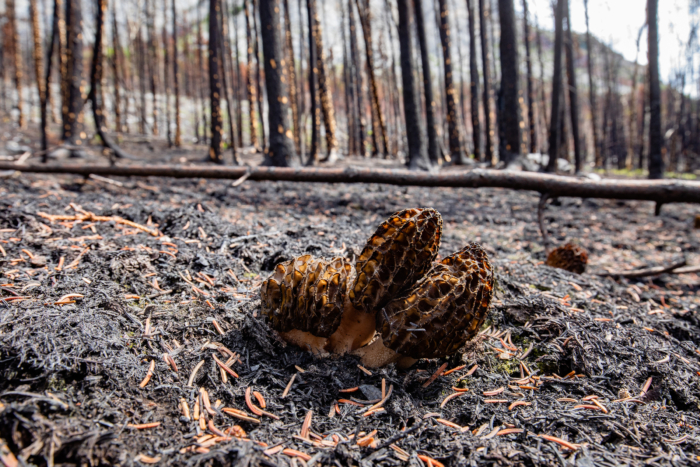
Morels love a burn area. “Burn morels” are the mushrooms that pop up after a fire burns through an area. These morels tend to be hardier than the rest of the morel family and are spurred to fruit in response to heat.
The mycelium of a burn morel attaches itself specifically to conifer trees and sits dormant until a fire comes through. Once the fire has scorched the earth and cooled, burn morels are known to pop up in unbelievable numbers and will for several seasons after the burn.
Preparing Morel Mushrooms
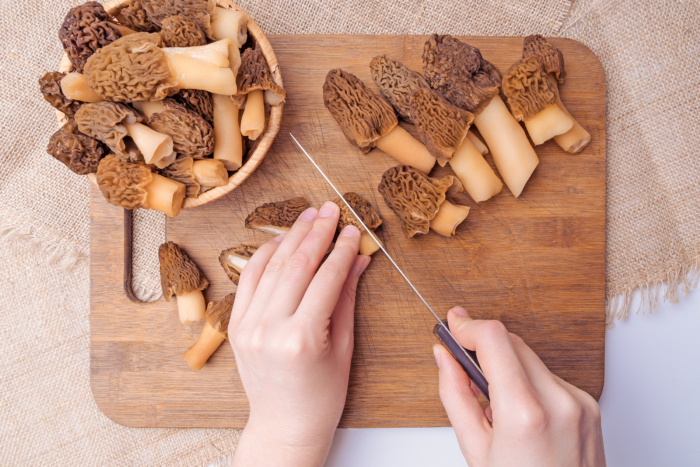
The most important factor for consuming the morels you forage is to cook them thoroughly. There have been a few deaths associated with undercooked morel mushrooms, though the actual mechanism of the illnesses that caused the deaths isn’t well understood. The takeaway is this: COOK YOUR MOREL MUSHROOMS.
Because of the areas these fungi grow in, they often have soil and debris on them. Instead of washing, it’s recommended you use a soft brush, like the one included on a mushroom knife, to brush away any extras you bring home with you.
You can then sauté them in butter, use them as a topping on pizza, add them to your morning omelet, toss them into spaghetti sauces, or, my personal favorite, use them to make a morel cream sauce and dump that on everything.
If you’re fortunate to harvest too many to eat like I am, you can dry them and rehydrate them for use throughout the year. I often end up drying a lot of morels, though they are so much better fresh.
I slice mine in half to ensure a thorough drying and pop them into my dehydrator. They’ll keep quite some time and are wonderful to add to meals when the winters grow long.
Now, go forth, forage, be careful, and eat your way through spring.
